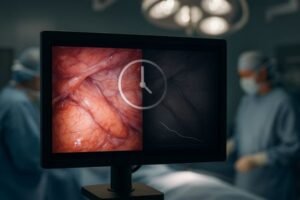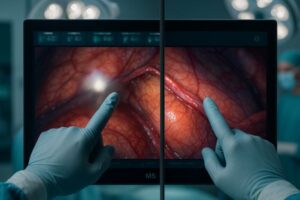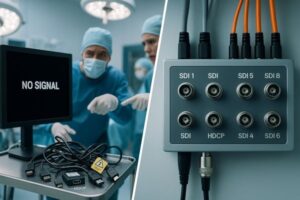Viewing a diagnostic image on an uncalibrated screen is like reading a map in the dark. Critical details are lost in the shadows, leading to inaccurate interpretations and compromised patient care.
The DICOM curve is the foundation of medical-grade displays, ensuring grayscale levels match human visual sensitivity. By aligning technology with visual science, DICOM GSDF guarantees consistent image quality, enabling greater diagnostic confidence.
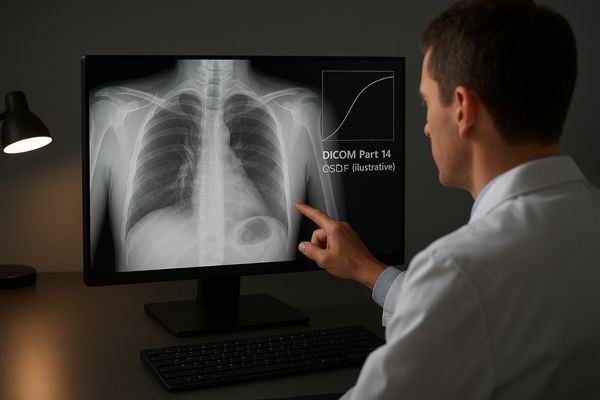
In the world of digital medical imaging, consistency is not just a preference; it is a clinical necessity. The DICOM (Digital Imaging and Communications in Medicine) Grayscale Standard Display Function1, or GSDF, is the global standard that makes this consistency possible. It ensures that regardless of the display used, a radiologist will perceive the same image details with the same level of clarity. This standard is built upon a deep understanding of human vision, transforming the subjective experience of viewing an image into an objective, repeatable science. This article will explore the core principles of the DICOM curve, explain why it is superior to standard display functions, and detail its profound impact on diagnostic accuracy2, regulatory compliance, and the future of medical imaging.
Understanding the DICOM GSDF Curve in Diagnostic Imaging
Without a standard, the same grayscale value would appear differently on every monitor. A faint lesion visible on one screen might be completely invisible on another, creating diagnostic chaos.
DICOM GSDF calibrates display luminance to match human visual sensitivity, using Just Noticeable Differences (JNDs) to ensure consistent perception of grayscale changes, especially at lower luminance levels.
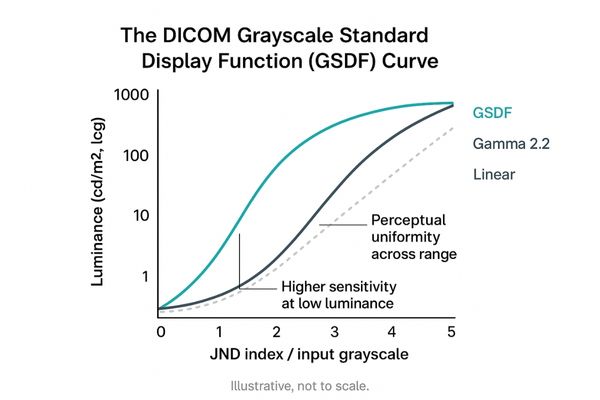
The DICOM GSDF3 is the cornerstone of modern diagnostic display technology. It is a standardized function defined in Part 14 of the DICOM standard, designed to ensure perceptually linear grayscale rendering. This means that changes between adjacent grayscale levels are equally noticeable to the human eye, regardless of where they fall on the brightness spectrum. This is based on foundational studies of human vision, which show that our eyes are far more sensitive to subtle changes in low-luminance (dark) regions than in high-luminance (bright) regions. The GSDF calibrates the monitor’s luminance response to align with these Just Noticeable Differences4 (JNDs). While DICOM Part 14 permits grayscale deviations within ±10%, advanced medical displays achieve much tighter control. For example, a premium monitor like the MD120C can perform automatic calibration to maintain an accuracy of ±5% or better. This level of precision is crucial in detail-sensitive applications like mammography and CT, where the ability to confidently discern low-contrast abnormalities directly impacts diagnostic outcomes.
Display Characteristic vs. GSDF Calibration: Why It Matters
Using a consumer monitor for diagnosis is a gamble with patient safety. Its standard gamma curve distorts grayscale perception, potentially hiding critical clinical information in plain sight.
A standard Gamma 2.2 curve differs from human perception and can obscure subtle details. GSDF calibration ensures consistent visibility across the full brightness range, dramatically improving diagnostic reliability.
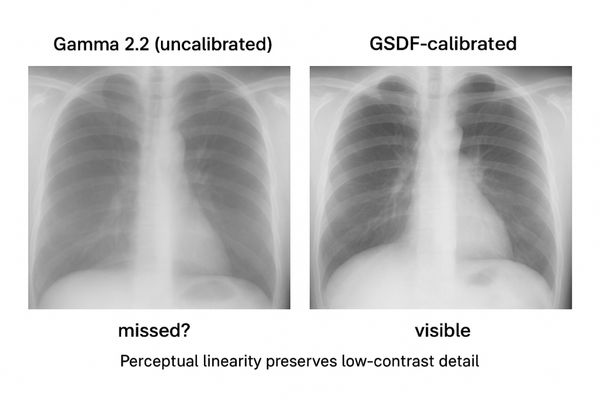
The fundamental difference between a consumer display and a medical-grade diagnostic monitor lies in their luminance response curves. Most consumer monitors are designed to a standard Gamma 2.2 curve, a legacy from old CRT television technology. While suitable for entertainment media, this curve does not align with the perceptual needs of diagnostic imaging. In contrast, medical displays are calibrated to the DICOM GSDF. The distinction is clinically significant. An uncalibrated monitor with a gamma curve might exhibit luminance deviations greater than 20% across its brightness range, especially in the darker grays where human vision is most sensitive. This can cause subtle but critical details—like microcalcifications in mammography or faint shadows in a lung nodule—to be "crushed" into black or washed out, rendering them invisible. A GSDF-compliant display, such as the MD85CA, reduces this deviation to within 5%. This ensures that every grayscale step is perceptually distinct and faithfully represents the underlying imaging data.
| Feature | Consumer Monitor (Gamma 2.2) | Medical Monitor (DICOM GSDF) |
|---|---|---|
| Curve Basis | Technical standard (legacy) | Human visual perception (JNDs) |
| Perceptual Linearity | Non-linear, inconsistent perception | Perceptually linear, consistent perception |
| Low-Grayscale Detail | Often lost or "crushed" | Accurately rendered and preserved |
| Luminance Deviation | Can exceed ±20% | Typically within ±10% (often < ±5%) |
| Diagnostic Reliability | Low; high risk of missed findings | High; ensures consistent interpretation |
This calibration is not a minor adjustment; it is a fundamental re-engineering of the display’s performance to serve as a reliable medical instrument.
Calibration Methods for GSDF Compliance in Medical Displays
A display’s performance naturally degrades over time. Without active management, a once-compliant monitor can drift out of specification, silently compromising diagnostic quality.
GSDF compliance is achieved through factory calibration, built-in sensors, and automated quality control systems that actively manage the display’s luminance curve and compensate for ambient light and aging.
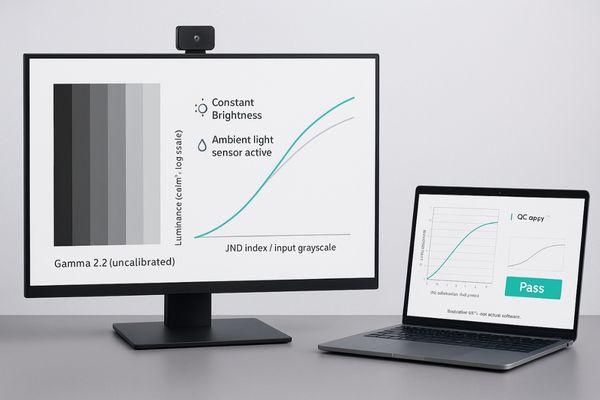
Maintaining GSDF compliance throughout a monitor’s lifespan requires a combination of sophisticated hardware and software. The process begins at the factory, where a unique Look-Up Table (LUT)5 is created for each display to correct its native response to the DICOM standard. However, this is just the starting point. To counteract the effects of backlight aging and environmental changes, advanced medical displays incorporate several layers of active calibration. Many models, like the MD26GA, feature a front-panel photometer or sensor that swings into place to measure the screen’s output and automatically recalibrate it without user intervention. Another critical feature is a Constant Brightness System (CBS)6 and an integrated ambient light sensor. The CBS provides luminance stabilization, while the ambient light sensor allows the display to compensate for fluctuations in room lighting, ensuring the GSDF curve remains accurate even as conditions change. Long-term data shows that displays with such systems maintain luminance stability within ±3% after thousands of hours of continuous operation, whereas uncalibrated models can degrade by over 15%. This automated DICOM quality control, found in models like the MD32C, is essential for busy PACS workstations.
Clinical Impact: DICOM Calibration Improves Diagnostic Accuracy
The link between display calibration and clinical outcomes is not theoretical. It is a documented fact that directly impacts a clinician’s ability to detect disease accurately.
Studies prove DICOM calibration significantly increases diagnostic accuracy. Detection rates for critical findings like microcalcifications can improve by over 15%, reducing the risk of misdiagnosis.
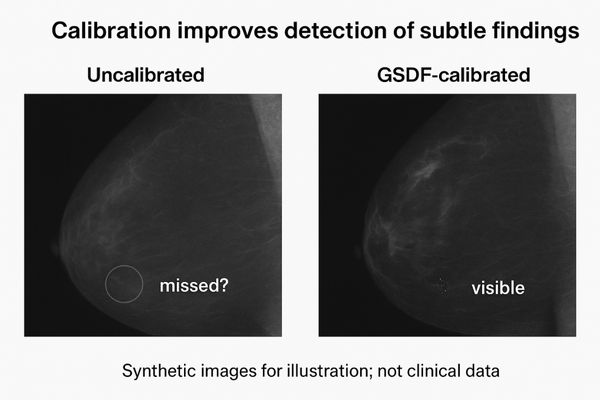
The clinical value of DICOM calibration is unequivocally supported by research. It is far more than a technical compliance requirement; it is a critical safeguard against misdiagnosis. Multiple studies have demonstrated a direct and significant improvement in diagnostic accuracy when clinicians use GSDF-compliant displays7. For instance, landmark studies in mammography revealed that the detection rate for subtle microcalcifications was only 72% on uncalibrated consumer-grade displays. When the same radiologists reviewed the cases on GSDF-compliant 5MP monitors, such as the MD52G, the detection rate jumped to 89%. Similar results have been observed in other modalities. In dental radiology, groups using calibrated displays showed 15–20% higher accuracy in identifying early-stage caries compared to their counterparts using uncalibrated screens. This evidence highlights a crucial truth: the display is an active participant in the diagnostic process. By ensuring that all clinically relevant grayscale information is perceptually visible, DICOM calibration8 acts as a foundational element of patient safety, turning a monitor into a trustworthy diagnostic tool like the duo-display MD45C.
Regulatory Standards and GSDF Compliance in Healthcare
In healthcare, quality is not optional. A rigorous framework of regulations and professional guidelines mandates the use of calibrated displays to ensure a consistent standard of care.
Global regulatory bodies like the FDA and CE, along with professional guidelines from the ACR and AAPM, mandate DICOM Part 14 compliance and regular QC for all primary diagnostic displays.
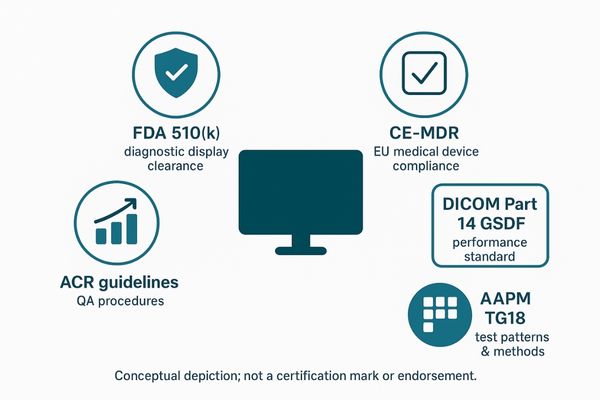
The requirement for DICOM GSDF compliance9 is firmly embedded in the global healthcare regulatory landscape. It is not a recommendation but a mandate for any display intended for primary diagnostic interpretation. In the United States, the Food and Drug Administration (FDA) requires 510(k) clearance for diagnostic displays, which includes verification of DICOM compliance. In Europe, the CE mark for medical devices similarly necessitates adherence to relevant performance standards. Beyond government regulations, professional organizations provide detailed quality assurance (QA) guidelines that are considered the standard of care. The American College of Radiology10 (ACR) and the American Association of Physicists in Medicine (AAPM) have published extensive protocols, such as AAPM TG18, which recommend routine verification of GSDF conformance. These tests are typically required every three to six months to ensure continued accuracy. This regular manual testing can be a significant workload for hospital IT and physics departments. To address this, high-end diagnostic monitors like the MD46C integrate automatic DICOM QC systems that perform these checks autonomously, generating compliance reports and minimizing manual labor and costs, which is vital for hospital quality assurance and reimbursement audits.
Future Trends of GSDF Calibration in Medical Imaging
The principles of DICOM GSDF are foundational, but the technology is not static. New imaging techniques and clinical workflows are driving the next evolution of display calibration.
Future trends include AI-driven adaptive calibration, the integration of GSDF with HDR for enhanced visibility, and a greater emphasis on unified standards to support global telemedicine and interoperability.

As medical imaging continues to advance, the application of GSDF calibration11 is evolving to meet new challenges. One of the most exciting emerging trends is the use of artificial intelligence to create adaptive calibration systems. An AI-driven display could dynamically adjust its luminance response based on the content of the image being viewed and real-time changes in ambient light, optimizing visibility for each specific diagnostic task. Another key trend is the integration of High Dynamic Range (HDR) technology12 with the GSDF standard. This allows displays like the [MD33G*](https://reshinmonitors.com/md33g-3mp-diagnostic-monitor/ "MD33G") to achieve peak brightness levels well over 1000 cd/m², enhancing the visibility of details in extremely bright or dark areas of complex images, which is particularly useful in surgical and interventional settings. Finally, the explosive growth of telemedicine and multi-center clinical trials is placing a greater emphasis on cross-device consistency. A unified and rigorously enforced GSDF calibration standard, easily managed on monitors like the [MD22CA](https://reshinmonitors.com/md22ca-2mp-diagnostic-monitor/ "MD22CA**"), is becoming the bedrock for global interoperability, ensuring that a clinician in one part of the world can confidently consult on an image viewed by a colleague thousands of miles away.
Conclusion
Interpreting the DICOM curve is essential for ensuring that medical displays function as precise instruments, directly supporting diagnostic accuracy and upholding the highest standards of patient care.
👉 To learn more about DICOM-calibrated medical displays and tailored solutions, reach out to Martin at martin@reshinmonitors.com — we’re ready to assist you.
-
Understanding the DICOM GSDF is crucial for anyone involved in medical imaging, as it ensures consistent image quality and diagnostic accuracy. ↩
-
Exploring the relationship between diagnostic accuracy and patient outcomes can provide insights into improving healthcare quality and effectiveness. ↩
-
Understanding DICOM GSDF is essential for anyone involved in medical imaging, as it ensures accurate grayscale rendering. ↩
-
Exploring JNDs can enhance your knowledge of visual perception, crucial for improving diagnostic display accuracy. ↩
-
Understanding LUTs is crucial for grasping how medical displays achieve DICOM compliance and maintain image quality. ↩
-
Exploring CBS technology reveals how it stabilizes luminance, enhancing the reliability of medical imaging. ↩
-
Exploring GSDF-compliant displays can reveal their significant impact on diagnostic accuracy, crucial for effective medical imaging. ↩
-
Understanding DICOM calibration is essential for improving diagnostic accuracy and patient safety in medical imaging. ↩
-
Understanding DICOM GSDF compliance is crucial for ensuring diagnostic accuracy and meeting regulatory standards in healthcare. ↩
-
Exploring ACR guidelines can enhance your knowledge of best practices in diagnostic imaging and quality assurance. ↩
-
Understanding GSDF calibration is crucial for optimizing medical imaging techniques and ensuring accurate diagnostics. ↩
-
Exploring HDR technology reveals its significant impact on enhancing image quality, vital for precise medical evaluations. ↩

